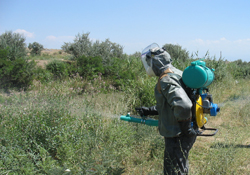Policy

WHO
Elimination of health risks from hazardous chemicals through the development and implementation of risk-reduction policies and strategies is a priority for Member States in the WHO European Region and for WHO/Europe.
European commitments
The Sixth Ministerial Conference on Environment and Health held in 2017 committed WHO/Europe and Member States in the Region to minimizing the adverse effects of chemicals on human health and the environment by:
- replacing hazardous chemicals with safer alternatives, including non-chemical ones;
- reducing the exposure of vulnerable groups to hazardous chemicals, particularly during early stages of life;
- strengthening capacities for risk assessment and research to secure a better understanding of human exposure to chemicals and the associated burden of disease; and
- applying the precautionary principle where appropriate.
Global and regional legally binding and voluntary initiatives
Several initiatives provide an important foundation for WHO/Europe’s activities in the area of chemical safety.
- The International Health Regulations (IHR) (2005) are a global legally binding instrument with 194 signatory countries. They provide a major framework to ensure adequate preparedness for and response to public health emergencies of international concern caused by all types of hazards, including chemicals.
- The Strategic Approach to International Chemicals Management (SAICM) is a policy framework that promotes international action on chemical hazards to ensure that, by the year 2020, chemicals are produced and used in ways that minimize significant adverse impacts on the environment and human health.
- The Minamata Convention is a legally binding agreement that aims to protect human health and the environment from the adverse effects of mercury. It includes a ban on primary mercury mining; the phase-out of existing mines and the phase-out and phase-down of mercury use in a number of products and processes; control of mercury releases into the environment and management of contaminated sites; and replacement of mercury in artisanal and small-scale gold mining.
- The Rotterdam Convention on International Trade in Hazardous Chemicals, Stockholm Convention on Persistent Organic Pollutants and Basel Convention on Transboundary Movement of Hazardous Wastes are three multilateral environmental agreements with the common objective of protecting human health and the environment from hazardous chemicals and wastes. Specifically, they address pesticides and industrial chemicals that are banned or severely restricted for human health or environmental reasons, protection of human health and the environment from persistent organic pollutants and from risks posed by hazardous wastes and their transboundary movement.
- The United Nations Economic Commission for Europe (UNECE) Convention on Transboundary Effects of Industrial Accidents is the regional treaty covering prevention of, preparedness for and response to industrial accidents. It aims to protect human health and the environment from accidental chemical and radiological releases.
Many Member States in the Region have created legal frameworks and established competent authorities for the management of chemicals. The majority of countries are parties to the Basel, Rotterdam, Stockholm and the Minamata Conventions, and participate in SAICM. European Union countries are also subject to the provisions laid down in relevant legislation, particularly the Registration, Evaluation, Authorisation and Restriction of Chemical Substances (REACH) regulation.
In April 2017, the countries of the Eurasian Economic Cooperation Organization adopted a technical regulation on chemicals. Its aim is to improve the protection of human health and the environment through better and earlier identification of the intrinsic properties of chemical substances and their effective regulation.



